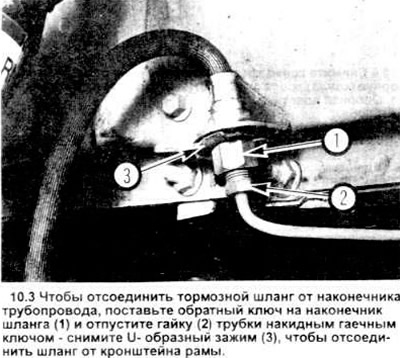Examination
1. Approximately every six months, the rubber hoses connected to the steel pipelines of the front and rear brake assemblies should be checked for cracks, abrasion of the outer coating, leakage, swelling and other damage, the operation is performed by raising the car on a lift. These are important and vulnerable parts of the brake system, so the check should be complete.
Replacement
Rubber hose
2. Clean the ends of the hose.
3. Disconnect the brake line from the hose end using a return wrench on the end. If necessary, moisten the connections with well-penetrating oil.

4. Remove the hose bracket bolts from the rack.
5. Remove the U-clip from the female lug on the bracket (see figure 10.3), remove the hose from the bracket.
6. Disconnect the hose from the caliper, and discard the removed copper washers on each side of the handpiece block.
7. Having put new copper washers, connect a new brake hose to a support.
8. Pass the female lug through the frame bracket. The hose should have some freedom of rotation, put it in the right position (to determine the possibility of rotation, use the red paint strip).
Note: The weight of the vehicle must be supported by the suspension, so there is no need to raise the vehicle to install the hose.
9. Install the U-clip on the female lug of the frame bracket.
10. Using on the handpiece "back" wrench, connect the brake lines to it.
11. Mount the brake hose bracket on the strut.
12. Carefully check and make sure that neither the suspension nor the steering gear parts should touch the hose. During the test, you can push the car, as well as turn the steering wheel from one extreme position to another.
13. Bleed the brake system as described in section 11.
Metal pipelines
14. When replacing elements of the brake system, use properly selected parts. Copper tubes must not be used in any brake system.
15. Use prefabricated tubing with lugs and connectors already fitted, bent to size.
16. When installing new piping, make sure it is securely fastened into the bracket and there is sufficient clearance to expand when heated.
17. After installation, check the brake fluid level and add fluid if necessary. Bleed the brakes as instructed section 11, check them out.
Visitor comments